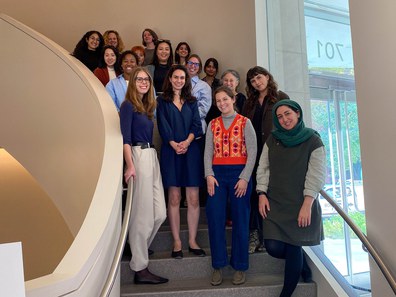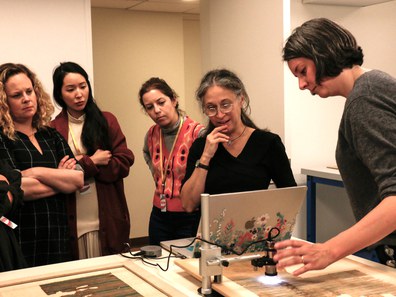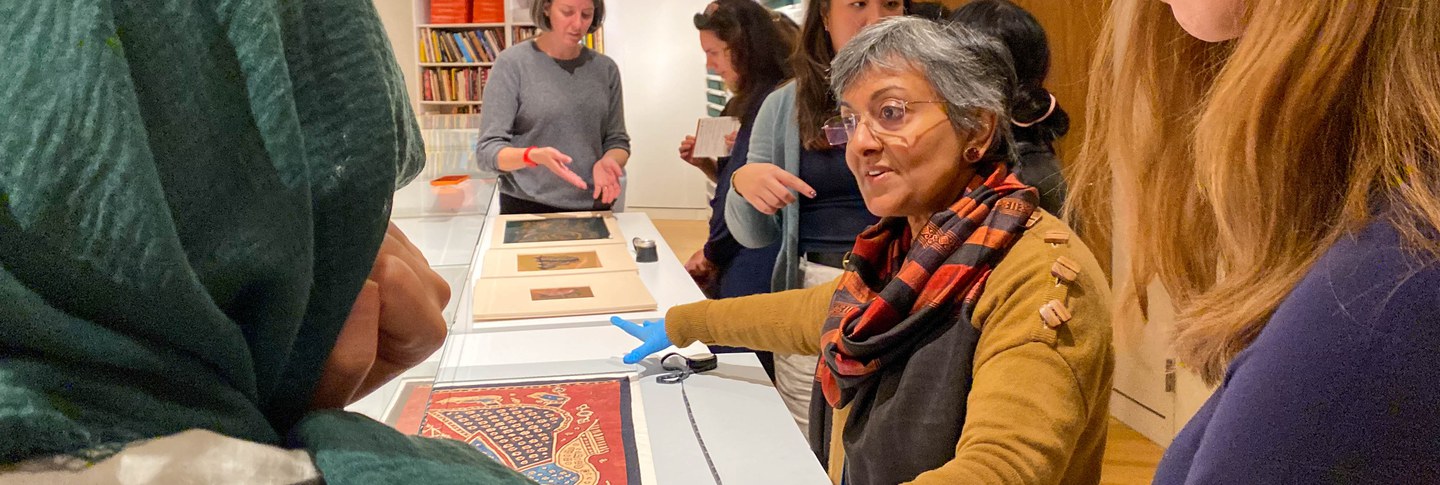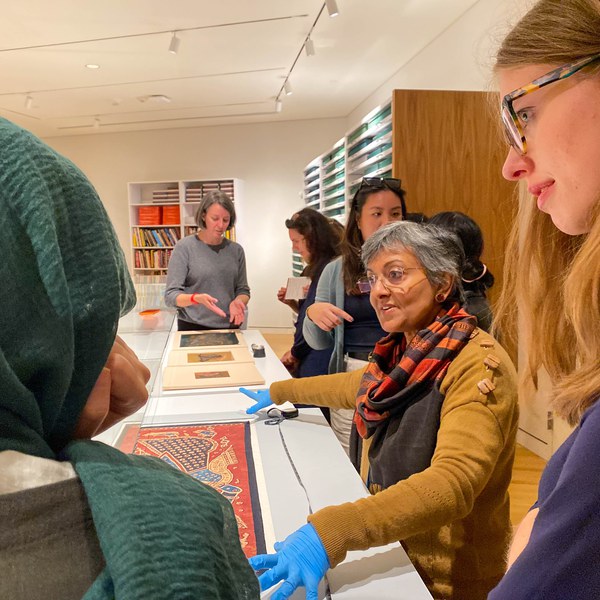The “Mediterranean interpretation of the Humanist disciplines” is a guiding principle of Dumbarton Oaks, one evoked in Mildred Bliss’s last will and testament. The meaning of this turn of phrase is debated, but it has been taken to mean a focus on the cultures of the classical and Byzantine worlds centered around that sea. In recent years, as scholarship has probed the limitations of traditional scholarly categories formed in land-based notions of empires and national identity, renewed interest in sea-based geographies offers opportunities to highlight the fluidities and mobilities of objects and people. The nature of this shift emerged in conversations throughout the 2023 Graduate Study Day organized in the Museum Department this month. The program, Egyptian Textiles and Indian Ocean Trade from the Late Roman through the Mamluk Periods illuminated the routes of raw materials and finished fabrics in networks connecting the Mediterranean and Indian Ocean zones in the late antique and medieval periods from roughly the fourth to fifteenth centuries CE.
 The Museum Graduate Study Day is a yearly program that connects graduate students with Dumbarton Oaks’s collections and the staff that care for them. An open call for participation sent out this summer on the theme of Indian Ocean textiles and maritime trade networks generated an enthusiastic response. In the end, Dumbarton Oaks welcomed twelve students from Cambridge University, Case Western University, Columbia University, CUNY Graduate Center, Florida State University, Harvard University, Johns Hopkins, Rutgers University, University of California-Los Angeles, and University of Chicago. Their expertise was global—covering materials from North and Eastern Africa, the Middle East, and Central, South, and Southeast Asia, as well as transhistorical—covering late antique, medieval, and early modern topics. The students’ disciplinary vantage points were complementary, with a mix of backgrounds in textiles in museum collections, textual sources, architectural decoration, and archaeological evidence. The assembled group represented the cutting edge of Indian Ocean studies, whose work is expanding the definition of the Middle Ages through collaboration in cross-cultural and transhistorical research.
The Museum Graduate Study Day is a yearly program that connects graduate students with Dumbarton Oaks’s collections and the staff that care for them. An open call for participation sent out this summer on the theme of Indian Ocean textiles and maritime trade networks generated an enthusiastic response. In the end, Dumbarton Oaks welcomed twelve students from Cambridge University, Case Western University, Columbia University, CUNY Graduate Center, Florida State University, Harvard University, Johns Hopkins, Rutgers University, University of California-Los Angeles, and University of Chicago. Their expertise was global—covering materials from North and Eastern Africa, the Middle East, and Central, South, and Southeast Asia, as well as transhistorical—covering late antique, medieval, and early modern topics. The students’ disciplinary vantage points were complementary, with a mix of backgrounds in textiles in museum collections, textual sources, architectural decoration, and archaeological evidence. The assembled group represented the cutting edge of Indian Ocean studies, whose work is expanding the definition of the Middle Ages through collaboration in cross-cultural and transhistorical research.
The morning presentations covered the state of research on Indian Ocean textiles from Egypt to Indonesia, with a focus on past and upcoming exhibitions presenting these fascinating objects to the public. An introduction by Study Day organizer Elizabeth Dospel Williams (Curator, Byzantine Collection), was followed by welcomes from Director Tom Cummins and Director of Byzantine Studies, Nikos Kontogiannis. The talks that followed addressed the trade, manufacture, and use of textiles across the Indian Ocean. Anna Kelley, a former Dumbarton Oaks junior fellow and now Lecturer in Ancient History, in the School of Classics at the University of St Andrews, outlined textual and archaeological evidence for Red Sea and Indian Ocean textile trade in Egypt in her talk, “Documenting the Indian Ocean Textile Trade in Late Antiquity.” Sumru Belger Krody, Senior Curator at The George Washington Museum and The Textile Museum, offered curatorial perspectives on Indian Ocean textiles in her presentation “Discovering Indian Textiles through Exhibitions.” The morning’s last speaker, Arielle Winnik, Postdoctoral Fellow in the Department of Indo-Pacific Art at the Yale University Art Gallery, focused on current and upcoming research on Indian textiles made for Indonesian markets in her talk, “Indian Ocean Textiles for Southeast Asia.”
 Students and instructors ventured to Museum Storage in the afternoon to study textiles up-close. This prompted discussion about techniques, materials, and visual qualities, but also raised pressing questions about provenance, the history of collecting, and the personalities involved in recommending such objects to Dumbarton Oaks. Building on the morning’s talks, cotton textiles received special attention. Perhaps the most extensive group discussion in the afternoon’s study session was on cottons manufactured in India and South Arabia and shipped to Egypt. Ranging from the tenth to fifteenth centuries, the textiles demonstrate a variety of patterns and techniques typical of Indian production in this period (BZ.1933.21; BZ.1933.23; BZ.1933.29; BZ.1933.33; BZ.1933.39; BZ.1933.49; BZ.1973.39). In a similar manner, cottons with Arabic inscriptions associated with production in tenth-century Yemen epitomized the transfer of raw materials, technical knowledge, and finished textiles along the Red Sea corridor on their way to East and North Africa (BZ.1933.42; BZ.1933.40; BZ.1933.37). The group then travelled to the Cotsen Textile Traces Study Center at The George Washington University Museum and The Textile Museum where they were welcomed by Academic Coordinator Karthika Audinet with a selection of Indian textile fabrics for trade in Egypt and Indonesia.
Students and instructors ventured to Museum Storage in the afternoon to study textiles up-close. This prompted discussion about techniques, materials, and visual qualities, but also raised pressing questions about provenance, the history of collecting, and the personalities involved in recommending such objects to Dumbarton Oaks. Building on the morning’s talks, cotton textiles received special attention. Perhaps the most extensive group discussion in the afternoon’s study session was on cottons manufactured in India and South Arabia and shipped to Egypt. Ranging from the tenth to fifteenth centuries, the textiles demonstrate a variety of patterns and techniques typical of Indian production in this period (BZ.1933.21; BZ.1933.23; BZ.1933.29; BZ.1933.33; BZ.1933.39; BZ.1933.49; BZ.1973.39). In a similar manner, cottons with Arabic inscriptions associated with production in tenth-century Yemen epitomized the transfer of raw materials, technical knowledge, and finished textiles along the Red Sea corridor on their way to East and North Africa (BZ.1933.42; BZ.1933.40; BZ.1933.37). The group then travelled to the Cotsen Textile Traces Study Center at The George Washington University Museum and The Textile Museum where they were welcomed by Academic Coordinator Karthika Audinet with a selection of Indian textile fabrics for trade in Egypt and Indonesia.
By the end of the day, it was clear that Indian Ocean textiles, though far-ranging geographically and chronologically, converge in compelling and sometimes surprising ways. From the “Mediterranean interpretation” of the humanities to one focused on the Indian Ocean, the 2023 Museum Graduate Study Day demonstrated the enormous value of bringing together diverse viewpoints to rethink traditional approaches to periodization, mediums, and geography, all mediated through the powerful experience of first-hand encounters with historical objects.
Elizabeth Dospěl Williams is Curator of the Byzantine Collection at Dumbarton Oaks.

